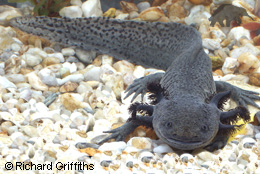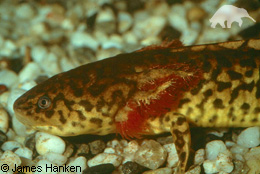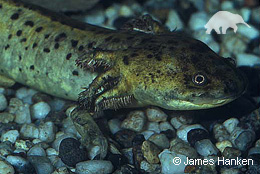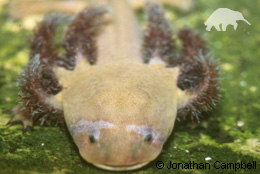Here is the first installment of resident blogger Darren Naish’s musings on EDGE Amphibians. Darren writes a regular Tetrapod Zoology blog, and introduced himself as an EDGE blogger earlier in the year. Here is what Darren has to say about the bizarre world of ambystomatid salamanders:
I’ve said it before and I’m sure I’ll be saying it again: as a life-long zoology nerd, one of my greatest frustrations has always been the fact that there are so many animals that get mentioned – only ever mentioned – but never elaborated upon. I’ve always liked Axolotls Ambystoma mexicanum, and among the world’s unusual amphibians this has got to be one of the most familiar, thanks of course to its widespread use in the pet trade and as a laboratory animal.
As everyone knows, the Axolotl is neotenous: it retains juvenile characters into sexual maturity, and even an adult is essentially an unmetamorphosed larva, exhibiting a perennibranchiate morphology (meaning that external gills are obvious). Unlike a metamorphosed salamander, a neotenous one retains external gills and a tail and body fin, lacks moveable eyelids, and of course is obligatorily aquatic. The books always say that the Axolotl is far from unique, but in fact one of several similar neotenous, perennibranchiate mole salamanders. What: there are other species like this? Well yes there are, and that’s what we’re going to look at here…
To begin with, it’s worth saying more about A. mexicanum, the Axolotl [wild-type Axolotl shown here]. Little known is that the wild population of this species is entirely restricted to Mexico’s Lake Xochimilco and Lake Chalco, and here they are Critically Endangered thanks to the pollution, habitat degradation and water extraction and resulting desiccation that has occurred.
Use of the animals for food and medicinal purposes, and predation from introduced fish, have also contributed to axolotl decline, and a 2004 survey failed to capture any axolotls in areas where they had formerly occurred (they aren’t thought to be locally extinct, however, as specimens continue to show up in local markets). A. mexicanum is one of the larger members of its group, with some individuals reaching 45 cm in total length (although this is exceptional and half this length is more normal).
The word ‘axolotl’ (‘ajolote’ in Spanish*) is usually thought to mean ‘water dog’ (it is probably not coincidental that other, non-ambystomatid perennibranchiate salamanders are today termed ‘mudpuppies’ and ‘waterdogs’), but it also has links to the concept of ugliness or monstrousness and is also often translated as ‘water monster’ (Smith 1969). All neotenous mole salamanders were originally termed axolotls, as were the larvae of metamorphosing species like the Tiger salamander A. tigrinum, and indeed this is still the case among laypeople (some people even, apparently, use ‘axolotl’ as the name for any larval salamander).
Herpetologists, however, have restricted the name to the perennibranchiate species A. mexicanum, and animals from this population have been well known to scientists since 1864 when a shipment of individuals were sent to Paris. Lake Xochimilco animals were again sent to Paris in 1868, and these Parisian axolotls were the ancestors of virtually all of the laboratory axolotls bred forever afterwards.
Early confusion as to whether perennibranchiate individuals should be given their own species or genus relative to metamorphosed individuals, and arguments as to whether A. mexicanum should be regarded as conspecific with the metamorphosing Tiger salamander, mean that the Axolotl has a complex nomenclatural history involving several appeals to, and actions of, the ICZN (International Code of Zoological Nomenclature – the organisation which ensures scientific names for animals are consistent and correct).
The Axolotl’s distinctive morphology and highly endangered status mean that it’s among the top 100 EDGE amphibians: you’ll recall from a previous Tet Zoo article (here) that EDGE species are Evolutionarily Distinct and Globally Endangered. Nine mole salamanders are on the EDGE list, and several of them are the poorly known neotenous, axolotl-like species I referred to above.
The tiger salamander complex
The Axolotl and Tiger salamander are mole salamanders, or ambystomatids, a group of exclusively American salamanders consisting of 33 or so species (we previously looked briefly at them in the second caudate article). The Tiger salamander – if recognised as a single species (read on) – is supposedly distributed over virtually the whole of continental North America, comprising between five and seven subspecies. Closely related to the Tiger salamander are an addition 13 or so species, all of which are unique to Mexico, and the Tiger salamander and its Mexican relatives are grouped together as the ‘tiger salamander complex’ on the basis of morphological and genetic data.
The California tiger salamander A. californiense might be the sister-taxon to the tiger salamander complex. However, DNA work has indicated that ‘the Tiger salamander’ is not really one species that is monophyletic with respect to the other members of the tiger salamander complex (Shaffer 1993, Shaffer & McKnight 1996).
Sorting out the taxonomy and phylogenetic relationships of the different Tiger salamander populations is a rather involved subject that need not concern us here, but one of the most interesting results of this work is the discovery that various of the Mexican neotenous members of the tiger salamander complex are very recently diverged and in fact may be ‘among the most recently derived vertebrate species known’ (Shaffer & McKnight 1996, p. 430).
Anderson’s salamander
Among the most recently named of mole salamanders is another neotenous species, Anderson’s salamander A. andersoni: it’s also on the EDGE list, and was only named in 1984 (Krebs & Brandon 1984). During field work in 1967, mole salamander expert James D. Anderson discovered a distinctive population of aquatic mole salamanders in and near Laguna de Zacupa (or Lake Zacupa) in Michoacan, Mexico. While clearly planning to describe the Laguna de Zacupa animals as a new species, Anderson died before publishing this work, and in 1970 the species was ‘discovered’ anew by Ronald A. Brandon and Ronald Altig. By combining Anderson’s notes and draft manuscript with new data, Brandon and Salome Krebs later published the species, naming it after Anderson.
A. andersoni is a robust, relatively short-tailed species with a reddish-brown background colour and numerous black spots. Its webbed, flattened toes are particularly short and it has a low number of gill rakers compared to other neotenous mole salamanders. A prominent keel is present on the lateral side of the hindfoot. In total length it reaches 21 cm.
The robust body, short tail and relatively small body fin of A. andersoni suggest that it’s a bottom-living species that inhabits running water, and collected specimens came from the stream that ran into Laguna de Zacupa. As with some other neotenous species, in its wild state A. andersoni has only ever been seen in its perennibranchiate stage. Individuals have spontaneously metamorphosed in the laboratory however, and in a few cases the metamorphosed animals lived on for a couple of years. Like the metamorphosed individuals of other neotenous species, these animals seemed to have trouble properly sloughing their skin (Krebs & Brandon 1984).
Salt-water salamander!
Taylor’s salamander A. taylori is another neotenous, perennibranchiate species on the EDGE list, and like the Axolotl it is extremely restricted in distribution, being unique – so far as we know – to one body of water, Mexico’s saline Laguna Alchichica. Yes, saline: what makes A. taylori particularly remarkable is that it is specialised for life in saline water (Taylor 1943).
It’s still true that lissamphibians (the group containing all recent amphibian species) cannot tolerate the sorts of salinities that amniotes can, but it is not true that anurans or caudates are thoroughly unable to deal with at least some salinity. Brackish water can be tolerated by the larvae and adults of some species: some frogs have even been reported to briefly swim in the sea as an escape tactic. Within Laguna Alchichica, A. taylori lives in deep water, occurring at depths below 30 m. The lake has a maximum depth of 64 m, but – as is typical for deep lakes -is thought by local people to be bottomless.
Phylogenetic studies indicate that A. taylori is part of an ‘eastern Mexican’ mole salamander clade that also includes A. andersoni, A. mexicanum and at least some ‘A. tigrinum‘ populations (Shaffer 1993). A. taylori is yellowish with small dark spots on its dorsal surface.
Are neotenous mole salamanders particularly closely related to one another, or has neoteny simply cropped up repeatedly among different mole salamander lineages? Actually, both possibilities are supported by different parts of the cladogram. Some neotenous taxa really are very close relatives (e.g., A. andersoni and A. taylori) and may have shared a neotenous common ancestor (note that some neotenous species are still capable of metamorphosing when conditions allow, so they can function as polymorphs, phasing in and out of a neotenous lifestyle).
Other neotenous species, like the Lake Pátzcuaro salamander A. dumerilii and Lake Lerma salamander A. lermaense, do not group closely with other neotenous species but with those that exhibit metamorphosis, and hence presumably evolved their neoteny separately [image shows A. dumerilii].
I had planned to write more about the obscure axolotl-like species, but conference preparation and a long list of other jobs are calling, so I have to leave it there. Please visit the EDGE amphibians site if you want more information. Remember also that we’re trying to bring the global amphibian crisis to wider attention this year, and that 2008 is Year of the Frog. If you’re concerned about the plight of axolotls and the many other endangered amphibians of the world, please do add your name to the Amphibian Ark online petition.
*Which confuses things, because this name is today used for Bipes, the limbed amphisbaenians
Refs – –
Fitzpatrick, B. M. & Shaffer, H. B. 2007. Hybrid vigor between native and introduced salamanders raises new challenges for conservation. Proceedings of the National Academy of Sciences 104, 15793-15798.
Krebs, S. L. & Brandon, R. A. 1984. A new species of salamander (family Ambystomatidae) from Michoacan, Mexico. Herpetologica 40, 238-245.
Shaffer, H. B. 1993. Phylogenetics of model organisms: the laboratory axolotl, Ambystoma mexicanum. Systematic Biology 42, 508-522.
– . & McKnight, M. L. 1996. The polytypic species revisited: genetic differentiation and molecular phylogenetics of the tiger salamander Ambystoma tigrinum (Amphibia: Caudata) complex. Evolution 50, 417-433.
Smith, H. M. 1969. The Mexican axolotl: some misconceptions and problems. BioScience 19, 593-597, 615.
Taylor, E. H. 1943. A new ambystomid salamander adapted to brackish water. Copeia 1943, 151-156.




